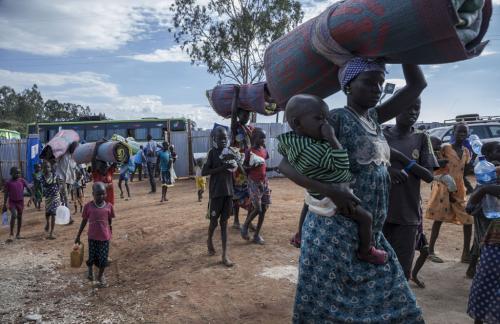Violence and persecution uprooted record 65.6 million people in 2016, UN agency reports
Nearly 66 million people were forcibly displaced from their homes last year, the United Nation refugee agency reported on Jun 19, stressing the “very high” pace at which conflict and persecution is forcing people to flee their homes.

South Sudanese refugees spend the night at a way station in Gimbi, Ethiopia while en route to the newly constructed Gure Shembola Camp.
The figure equates to “one person displaced every three seconds – less than the time it takes to read this sentence.”
The report Global Trends, released by the Office of the UN High Commissioner for Refugees (UNHCR), marks a jump of 300,000 since the end of 2015.
“By any measure this is an unacceptable number,” said UN High Commissioner Filippo Grandi, urging “solidarity and a common purpose in preventing and resolving crisis.”
He also called for properly protecting and caring for the world's refugees, internally displaced and asylum-seekers – who currently number 22.5 million, 40.3 million, and 2.8 million, respectively.
According to the report, Syria remains “the world's biggest producer of refugees” with 12 million people living in neighbouring countries and away from the region. There are 7.7 million displaced Colombians, 4.7 million Afghans and 4.2 million Iraqis.
However, in 2016, South Sudan became “the biggest new factor” when peace efforts broke down in July resulting in some 737,400 people fleeing by the end of the year.
Nyawet Tut, a South Sudanese mother of five in her 30s, described how soldiers set fire to her village and she had to run for her life with her own five children and five others of relatives killed in the conflict.
“My husband was killed in the war which, in addition to the shortage of food, made me decide to leave my home, everything, behind,” she told UNHCR staff during an interview at a temporary way station in Ethiopia.
In total, about 3.3 million South Sudanese had fled their homes by the end of the year, in what is known as the fastest-growing displacement of people in the world.
Youngest faces of war
About half of the refugee population last year were children younger than 18 years of age, according the report.
This is in contrast to the fact that children make up only about 31 per cent of the total world population.
Among its findings, the report noted that some 75,000 asylum claims were received from children travelling alone or separated from their parents. These include youngsters like Tareq, 16, who dodged armed combatants to walk out of Syria into neighbouring Turkey.
“There was no future where we lived,” he told UNHCR. “There was no university and no work. There were troops grabbing young children like me, and they send them to war, and they get killed. I wanted to study.”
Seeking refuge in poor countries
Developing countries are hosting the majority of the world's refugees, UNHCR reported.
About 84 per cent of the people were in low- or middle-income countries as of end 2016. Of that figure, one in every three people, roughly 4.9 million people, were hosted by the least developed countries.
“This huge imbalance reflects several things including the continuing lack of consensus internationally when it comes to refugee hosting and the proximity of many poor countries to regions of conflict,” the UN agency said.
In addition, the figure “illustrates the need for countries and communities supporting refugees and other displaced people to be robustly resourced and supported,” UNHCR said, warning that the absence can create instability in the host countries.
The report is being released on the eve of World Refugee Day, marked annually on 20 June.
Source:United Nations
- 236 reads
Human Rights
Ringing FOWPAL’s Peace Bell for the World:Nobel Peace Prize Laureates’ Visions and Actions

Protecting the World’s Cultural Diversity for a Sustainable Future

The Peace Bell Resonates at the 27th Eurasian Economic Summit

Declaration of World Day of the Power of Hope Endorsed by People in 158 Nations

Puppet Show I International Friendship Day 2020

